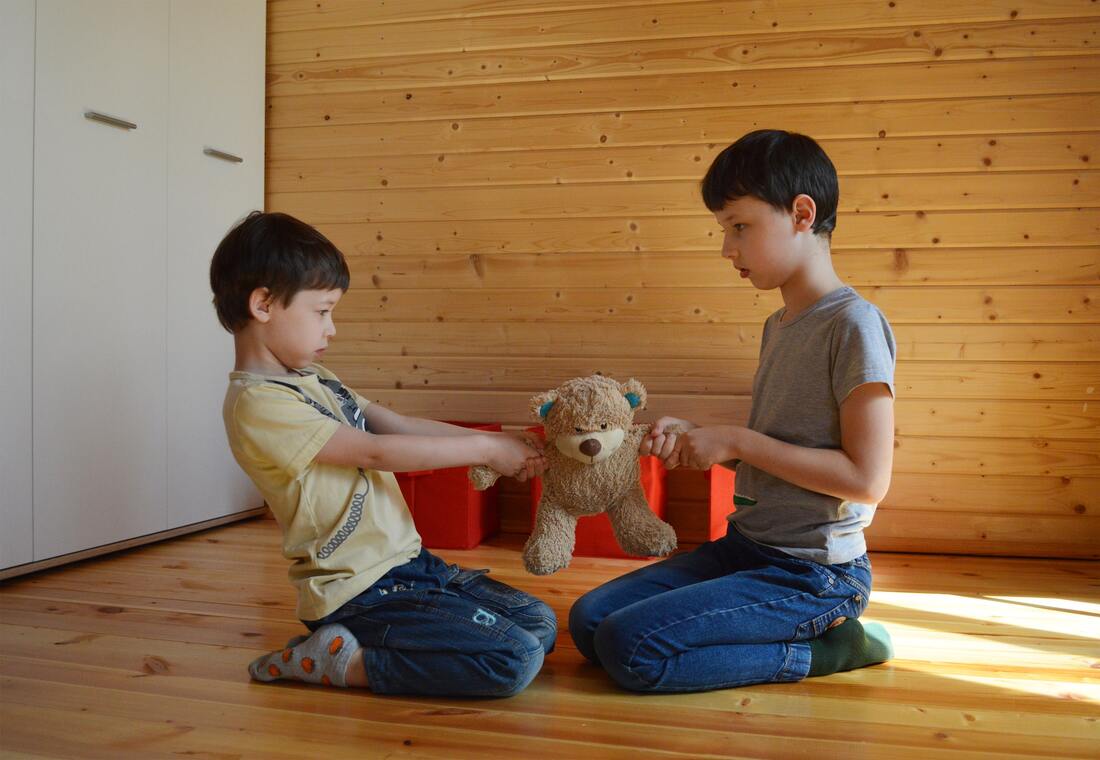|
Near the end of the school year, our Pre-K classroom became the foster home for Cooper, a therapy dog in training. We made it official and Heights Cooperative Preschool has adopted Cooper, and she will have a very important job on our team when school starts in September. Cooper came to us from the Cuyahoga County Animal Shelter, where she was taken after being found abandoned in a park with her siblings. Unfortunately, none of her brothers and sisters survived, and Cooper was in need of a lot of cuddles, love, and compassion. Our PreK students were more than happy to deliver an extra large dose of puppy love!
Similar to a service dog, Cooper is working in our school. But she’s also here to be our friend! While a service dog is trained to support an individual person, Cooper is here to help all of us feel better at school. Cooper is still in the process of her therapy dog certification program, and two of our students have volunteered to train with her so that they know her commands and have a strong bond. They are our Cooper Captains and will help the other students learn how to best interact with Cooper. We’ll be keeping things safe and clean in the classroom – Cooper gets regular breaks to potty outside and we wipe her paws so that she does not bring dirt inside. We also practice hand-washing if Cooper happens to give kisses while she’s still in training. Benefits of Therapy Dogs in the Classroom Therapy dogs provide support for students’ growing social and emotional skills. She has already been helping our students feel more confident, motivated, and relaxed! In addition to social and emotional benefits, therapy dogs have been shown to have a positive impact on attendance rates. Research indicates that students who have regular interactions with therapy dogs are more likely to attend school regularly. This could be attributed to the fact that these furry friends provide a sense of comfort and security, making students feel safe and motivated to come to school. Therapy dogs can also improve executive functioning skills. Tasks like planning, organizing, and prioritizing may become easier as students engage with these animals. The presence of therapy dogs has been found to enhance cognitive abilities and increase attention span in students of all ages from elementary school to college! Additionally, reading skills can greatly benefit from the presence of therapy dogs. Many schools have implemented programs where students read aloud to these non-judgmental and attentive companions. This practice not only helps build confidence in struggling readers but also creates a positive association with reading. Lastly, problem-solving skills tend to improve when students interact with therapy dogs. These animals offer unconditional love and support, providing a safe space for students to work through challenges they may be facing, like big changes at home or moving up to a new grade in school.
0 Comments
It’s the last day of Pride month – but it’s never too late to stand up for our values and shout out what makes us great! At Heights Cooperative, we believe that diversity makes us stronger and that celebrating love and self-expression is a year-round activity.
Diversity in Books Starting with Circle Time in our classrooms, we introduce different types of people, families, and cultures with books from diverse authors and communities. At Heights we make sure to talk about all different kinds of stories! Children are naturally curious about their visible differences like skin color, clothing, hair, braces, glasses, visible disabilities, etc. It’s also important to talk about the things we can’t see on the surface, like invisible disabilities, family dynamics, and more. Some of our favorites that speak to LGBTQ+ diversity are Love Makes a Family by Sophie Beer, Teo’s Tutu by Maryann Jacob Macias, ABC Pride by Louie Stowell and Elly Barnes, Julian is a Mermaid by Jessica Love, and Pink, Blue, and You by Elisa Gravel with Mykaell Blais. In this article for the Buckeye Flame, Mx. Taryn says, “It’s important to have books where the LGBTQ story isn’t the entire focus. Why can’t there just be a book where two dads pick their kid up, or you’re at a birthday party with two moms? It just needs to be normalized, kids need to see that as much as they see heterosexual examples.” On this note, we love books like Federico and All His Families by Mili Hernandez, Cookies and Cake & the Families We Make by Jennifer L. Egan, Gabrielle’s Gift by Lerone Landis, and Miss Molly Learns Responsibility by Kathleen S. Pero. And we also want to shout out the book Bodies Are Cool by Tyler Feder – which is about body diversity including size and ability, but can easily incorporate education about gender expression in different bodies too. Every Family is Different At Heights, you might have noticed a few changes to the words we use to describe family members. Not every student has one mom and one dad, so we talk about people’s grown-ups! This covers so much more than LGBTQ+ families too – if a student lives with an aunt or uncle, grandparent, or other adult, we want their families to be recognized just as much as students who live with mom and dad. The assumption that everyone has a mom and dad, and that they are happily married, isn’t true for many people, so we celebrate all kinds of families and encourage our students to appreciate their own unique family structure. This includes friends of the family and non-related aunties and uncles too! Maybe this summer, you could invite all of your family (blood related and not!) to share in celebration of everything you’ve accomplished and built together. Kids Understand and Celebrate Differences! It’s so beautiful to see the ways that our students learn about and appreciate the differences between themselves and their friends. Whether that means using different pronouns, recognizing cultural and racial differences, or finding ways to accommodate and include disabled friends, at Heights we are all about celebrating the things that make us different and bring us together! Photo by Alex Jackman on Unsplash Kari BurchDr. Kari is an Occupational Therapist and Certified Transformational Parenting Coach. She loves following her heart and helping others do the same, especially when it comes to changing the way we parent the next generation of leaders and learners. When you get down to brass tacks, small children do not yet have enough language and verbalization skills to let us know exactly what they want or need. So, when they are having a hard time, sometimes what we see are “behaviors” like tantrums and acting out.
What if instead of seeing “behaviors” that need to be corrected, we try to get to the bottom of what’s going on for the child? How to Look Under the Surface Consider an iceberg. The tip of the iceberg is the behavior you see (maybe a behavior like crying, biting, hitting, or saying ‘no’). But underneath the tip of that iceberg are the causal factors. Beneath the waterline, we find all the reasons WHY the behavior may be occurring. It could be many things such as:
Underlying any behavior could be one, or a combination, of the above factors! So, instead of only correcting behaviors or explaining WHY they can’t do something - explore underlying needs that may be present that you can address. In other words, don’t just look at the tip of the iceberg, look beneath the surface too! Simple Ways to Connect and Communicate We will address more communication strategies in a future blog, but here’s a simple starter for when a behavior is occurring: the AVR. (Acknowledge - Validate - Reassure).
We hope this was helpful! Share your lightbulb moments with us! Kari BurchDr. Kari is an Occupational Therapist and Certified Transformational Parenting Coach. She loves following her heart and helping others do the same, especially when it comes to changing the way we parent the next generation of leaders and learners. Earth day is a wonderful day to teach kids about a variety of topics relating to respecting and loving planet earth. Here are a few fun and simple activities to try for all ages and interests to help your child grow their love of our world.
Recycled Art Find trash or recyclable materials around your home you can use for a painting project. You can use items such as toilet or paper towel rolls, boxes, ribbon wheels, paper bags, and more. Use paper bags from the grocery store or a posterboard as the background. Dip the ends of the toilet or paper towel rolls in some paint and make circle shapes on the paper! You can talk about how you can repurpose trash or single use items, and give them a second life and use before throwing them away.
See examples and learn more about this idea from No Time for Flash Cards: Recycled Art For Earth Day - No Time For Flash Cards Outside Observations This one is simple but beautiful. Go outside and make observations about the earth and nature (even if it’s just in your yard!) Collect sticks and twigs, pine needles, or leaves. Collect small rocks. Notice different kids of weeds or flowers. Look for wildlife or signs of wildlife such as birds, squirrels, insects, or bugs. You can talk about how all of these work together to make a beautiful planet. We are so lucky to have so much to look at outside! Earth Day Play Dough Did you know it's super simple to make your own homemade play dough? Try this recipe from Pre-K Pages! Along with green and blue play dough, find stones and twigs from outside. You can form the dough into land with trees (made with green dough for the leaves and twigs for the trunk). You can make the ocean with blue play dough or sculpting clay, and fill with fish made from play dough, seaweed made from green play dough, and stones for the bottom of the ocean. Here’s more inspiration: Earth Day Theme Play Dough for Preschool - Pre-K Pages. You can talk about how some animals live on land and some live in the water, even incorporating some of your kiddo's favorite books or tv show characters and identifying their habitats. Enjoy talking about the earth and all its diversity! Visit Your Local Library for Earth Day Activities There are countless free community resources available locally for Earth Day, including at the library! Check out your local library or community center for Earth Day story times, art projects, and more. Litter Bug Jaunt Take a little walk around your neighborhood and pick up trash. This is a great time to instill messages about littering and how to keep our earth clean and healthy. For older kids, you can teach about the principles of "Leave No Trace" to keep the planet free of the impact of our trash. Will you give one of these ideas a try? Report back and tell us how it went! P.S. We're raising money for sustainable initiatives including new outdoor play spaces and low waste materials. You can donate here. |




 RSS Feed
RSS Feed